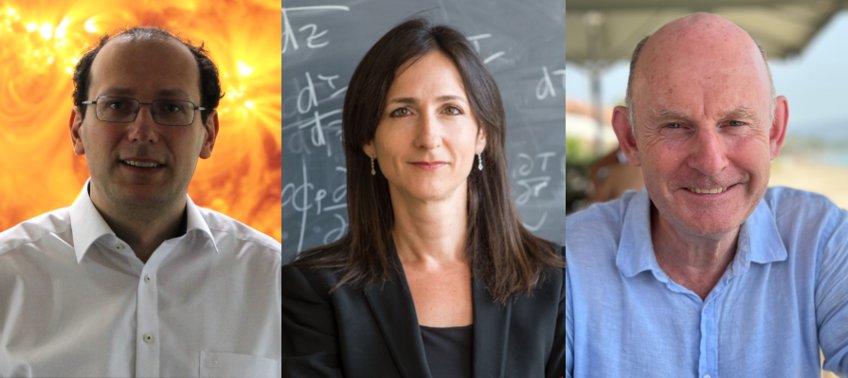ERC Synergy Grant for research project REVEAL
In the search for life-friendly exoplanets, researchers from Germany, the UK and the USA join forces in a pioneering research project.
One of the biggest obstacles in the search for exoplanets similar to Earth are their stars. The brightness and wavelengths of the light emitted by a star may vary greatly thus making it difficult for even the most advanced telescopes to detect evidence of Earth-like planets and their life-friendly atmospheres in it. The joint research project REVEAL of the Max Planck Institute for Solar System Research (MPS, Germany), the University of St Andrews (United Kingdom), the Massachusetts Institute of Technology (USA) and the Space Telescope Science Institute (USA) now brings together leading experts in exoplanet and stellar activity research to overcome this problem. Their goal is to unravel which traces in the starlight point to a life-friendly exoplanet and which are an expression of the star itself. The European Research Council (ERC) will fund this project for the next six years within the framework of a ERC Synergy Grant. In the long run, REVEAL may help answer one of humanity's oldest questions: Are we alone in the Universe?

The exoplanets that interest many researchers most are the hardest to find. Rocky planets outside our own Solar System that resemble Earth and also may have environmental conditions conducive to life are of rather modest size compared to most known exoplanets - and thus much harder to detect. In recent decades, modern telescopes on Earth and in space have increasingly succeeded in detecting smaller planets. But for some years now, this development has slowed. Earth twins orbiting Sun-like stars remain elusive even with the latest technology. And searching for evidence of gases indicative of life in the atmospheres of small planets is nearly impossible, even with NASA’s James Webb Telescope, which was commissioned last year.
The main reason for these difficulties lies in the nature of the stars themselves. Like the Sun, they do not always shine in the same way: dark star spots and bright regions cover their surfaces with changing abundancy; and the surface pattern created by rising hot plasma from a star's interior also varies constantly. "The variability of many Sun-like stars is much stronger than that of the Sun," explained Dr. Alexander Shapiro of the MPS, one of REVEAL’s three Principal Investigators. "Especially in the case of small, Earth-like planets, stellar activity obscures the traces left by a planet and its atmosphere in the starlight," he adds.
To solve this problem, the REVEAL project aims to first understand stellar behavior in detail. In a first step, the researchers intend to model stellar activity for a wide variety of stars in computer simulations. In a second step, they will calculate how this activity affects the light that telescopes capture from these stars. Only in this way is it possible to truly understand real observational data and separate which signals within it arise from exoplanets and their atmospheres and which are due to the star itself.
To accomplish this challenging task, REVEAL brings together leading experts from both the field of stellar activity and exoplanet research. While the research group led by Prof. Andrew Collier Cameron from the University of St Andrews works on the detection and characterization of exoplanets using Earth-based spectrometers, the group led by Prof. Sara Seager from the Massachusetts Institute of Technology in the USA searches for evidence of life-friendly atmospheres in observational data from NASA's James Webb Telescope. Dr. Alexander Shapiro's group at MPS is responsible for the stellar simulations using sophisticated magnetohydrodynamic models. Additional experience in observing stellar activity is contributed by the partner group led by Dr. Jeff Valenti of the Space Telescope Science Institute in the United States.
“Only by combining expertise in stellar and exoplanet physics can we get closer to finally concluding one of the most exciting quests in modern astronomy – the quest for habitable worlds outside our own Solar System”, said Dr. Alexander Shapiro.
Over the next six years, the ERC will support the REVEAL (Revealing Signatures of Habitable Worlds Hidden by Stellar Activity) project with almost 9.5 million Euros within the framework of an ERC Synergy Grant. ERC Synergy Grants are reserved for particularly ambitious research projects that are so large in scope and require such diverse expertise that they cannot be handled by a single research group alone. Out of a total of 395 applications, only 37 projects were selected for funding in the current funding round.
For MPS, this is the second time to receive an ERC Synergy Grant. In 2018, the ERC funded the WHOLESUN project, which investigates the origin of the Sun's magnetic activity. For REVEAL-Principal Investigator Dr. Alexander Shapiro of the MPS this is also the second time to be distinguished with a grant from the ERC. In 2017 he received an ERC Starting Grant to study brightness fluctuations of the Sun and stars.












